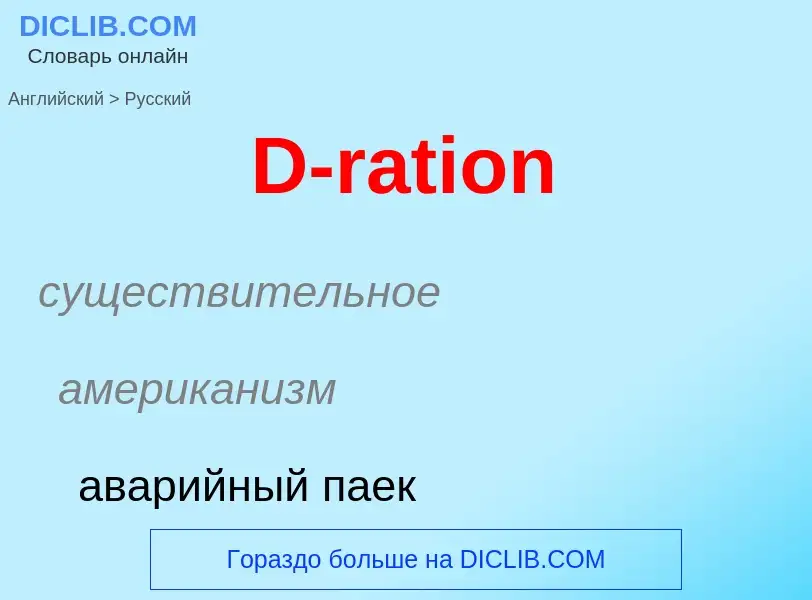Перевод и анализ слов искусственным интеллектом ChatGPT
На этой странице Вы можете получить подробный анализ слова или словосочетания, произведенный с помощью лучшей на сегодняшний день технологии искусственного интеллекта:
- как употребляется слово
- частота употребления
- используется оно чаще в устной или письменной речи
- варианты перевода слова
- примеры употребления (несколько фраз с переводом)
- этимология
D-ration - перевод на русский
существительное
американизм
аварийный паек
Определение
Википедия

Military chocolate has been a part of standard United States military rations since the original D-ration bar of 1937. Today, military chocolate is issued to troops as part of basic field rations and sundry packs. Chocolate rations served two purposes: as a morale boost, and as a high-energy, pocket-sized emergency ration. Military chocolate rations are often made in special lots to military specifications for weight, size, and endurance. The majority of chocolate issued to military personnel is produced by The Hershey Company.
When provided as a morale boost or care package, military chocolate is often no different from normal store-bought bars in taste and composition. However, they are frequently packaged or molded differently. The World War II K ration issued in temperate climates sometimes included a bar of Hershey's commercial-formula sweet chocolate. But instead of being the typical flat thin bar, the K ration chocolate was a thick rectangular bar that was square at each end. (In tropical regions, the K ration used Hershey's Tropical Bar formula.)
When provided as an emergency field ration, military chocolate was very different from normal bars. Since its intended use was as an emergency food source, it was formulated so that it would not be a tempting treat that troops might consume before they needed it. Even as attempts to improve the flavor were made, the heat-resistant chocolate bars never received enthusiastic reviews. Emergency ration chocolate bars were made to be high in energy value, easy to carry, and able to withstand high temperatures. Withstanding high temperatures was critical since infantrymen would often be outdoors, sometimes in tropical or desert conditions, with the bars located close to their bodies. These conditions would cause typical chocolate bars to melt within minutes.




![British Army Reservists]] cooking their field rations using a hexamine stove British Army Reservists]] cooking their field rations using a hexamine stove](https://commons.wikimedia.org/wiki/Special:FilePath/Army Reservists Cooking During an Exercise MOD 45156164.jpg?width=200)
![A British ration from the [[Second Boer War]], consisting of beef [[bouillon cube]]s and compressed [[cocoa powder]] in an early tin can A British ration from the [[Second Boer War]], consisting of beef [[bouillon cube]]s and compressed [[cocoa powder]] in an early tin can](https://commons.wikimedia.org/wiki/Special:FilePath/Boer war ration tin (FindID 216813).jpg?width=200)
![The contents of a ''[[Bundeswehr]]'' field ration from 1974 The contents of a ''[[Bundeswehr]]'' field ration from 1974](https://commons.wikimedia.org/wiki/Special:FilePath/Einmannpackung Typ1 Inhaltsübersicht.jpg?width=200)
![The contents of an [[Estonian Defence Forces]] field ration, featuring food in a variety of different packaging The contents of an [[Estonian Defence Forces]] field ration, featuring food in a variety of different packaging](https://commons.wikimedia.org/wiki/Special:FilePath/Estonian armed forces combat ration (opened).jpg?width=200)
